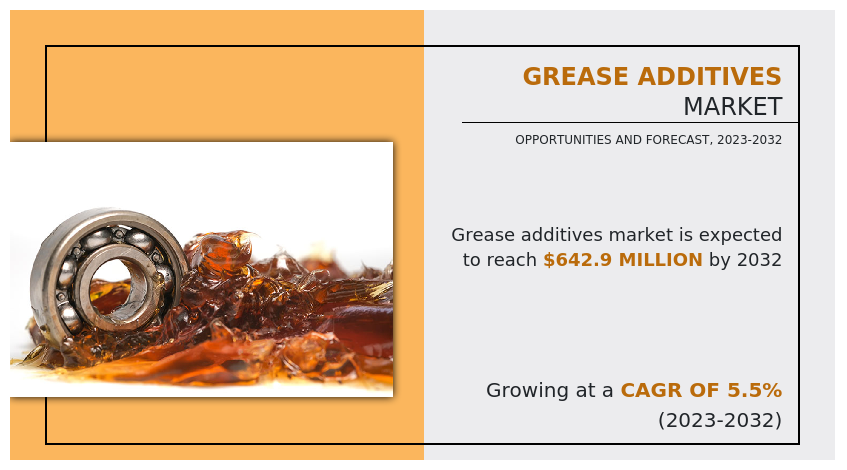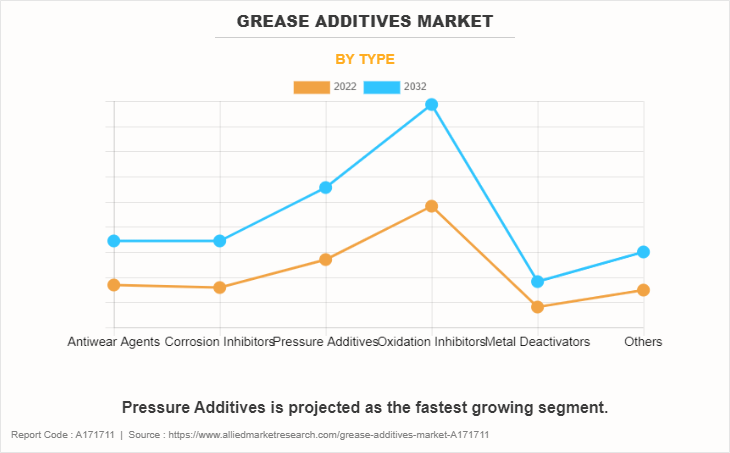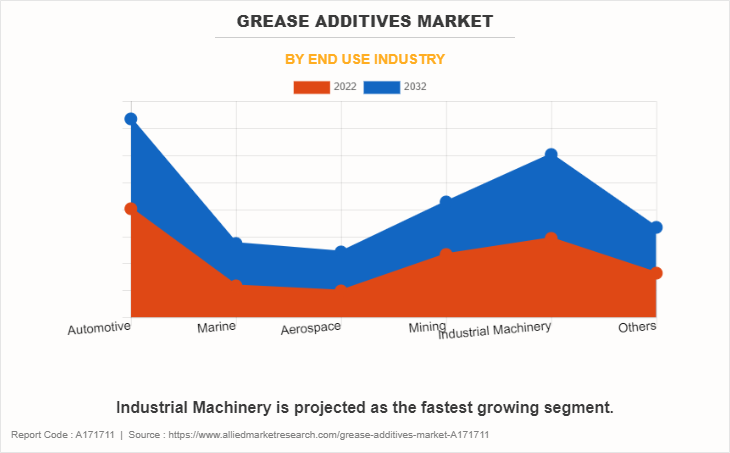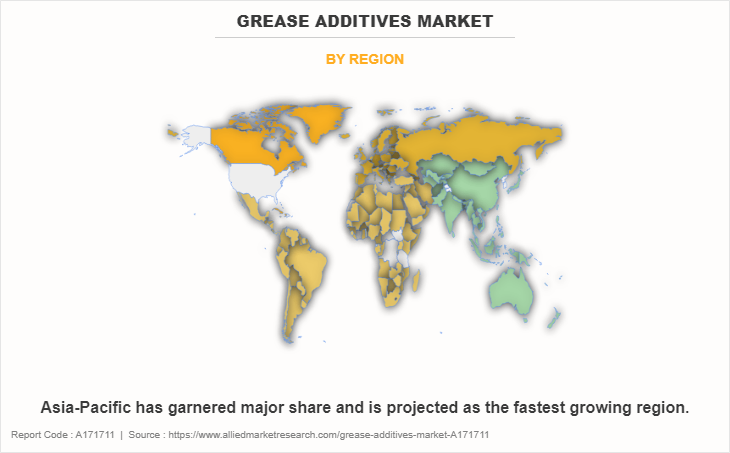Grease Additives Market Research, 2032
The global grease additives market was valued at $380.7 million in 2022 and is projected to reach $642.9 million by 2032, growing at a CAGR of 5.5% from 2023 to 2032.
Report Key Highlighters:
- The grease additives market study covers 20 countries. The research includes a segment analysis of each country in terms of value ($million) and volume (Kilotons) for the projected period 2023-2032.
- The study integrated high-quality data, professional opinions and analysis, and critical independent perspectives. The research approach is intended to provide a balanced view of global markets and to assist stakeholders in making educated decisions in order to achieve their most ambitious growth objectives.
- Over 3,700 product literature, annual reports, industry statements, and other comparable materials from major industry participants were reviewed to gain a better understanding of the market.
- The grease additives market has several players including BASF SE, The Lubrizol Corporation, CLARIANT, Afton Chemical, Croda International Plc, Evonik Industries AG, LANXESS, Innospec Inc., R.T Vanderbilt Holding Company and Chevron Oronite Company LLC.

Grease additives are specialized chemical compounds incorporated into lubricating grease to enhance their performance and longevity in various industrial and automotive applications. These additives are designed to improve the lubricating properties of the grease, protect metal surfaces from wear and corrosion, and maintain grease consistency over a wide range of operating conditions. One essential category of grease additives includes anti-wear agents, which form a protective film on metal surfaces to reduce friction and prevent mechanical wear.
Another crucial group of additives consists of rust and corrosion inhibitors, which shield metal components from moisture and chemical attack. In addition, extreme pressure (EP) additives are employed to maintain lubrication integrity under high-pressure conditions, such as in gears and bearings. Other common grease additives include thickeners to control viscosity, antioxidants to prevent oxidation and degradation, and friction modifiers to further reduce friction and improve energy efficiency.
The increasing demand from the aerospace and defense sectors is poised to be a significant driver of growth in the grease market.
These industries have unique and stringent lubrication requirements due to the critical nature of their applications, such as aircraft engines, landing gear systems, and military equipment. Aerospace and defense applications demand high-performance grease formulations that can withstand extreme conditions, including high temperatures, pressures, and harsh environments. In the aerospace industry, the rapid expansion of air travel, both commercial and military, has led to a surge in demand for advanced grease solutions. Aircraft manufacturers and operators require grease additives that ensure smooth operation, reduce friction, and enhance fuel efficiency.
Moreover, the defense sector's need for grease additives extends to applications in military vehicles, weapons systems, and naval vessels, where reliability and performance are important. The growth in these sectors is driving R&D efforts to create specialized grease formulations that meet the stringent requirements of aerospace and defense applications.
The increased demand for specialty greases is poised to be a significant driver of growth within the grease market.
This demand surge is primarily attributed to the rising need for highly customized and specialized lubrication solutions across various industries, including aerospace, marine, food processing, and more. These sectors demand greases with precise performance attributes tailored to their unique operating conditions and requirements. In the aerospace industry, for instance, specialty greases are crucial for ensuring the safe and efficient functioning of aircraft components subjected to extreme temperatures and pressures. Likewise, the marine sector relies on specialized greases to combat the corrosive effects of saltwater and harsh environmental conditions.
In addition, the food processing industry necessitates food-grade greases that meet stringent hygiene and safety standards. This growing specialization within industries is prompting grease manufacturers to develop and offer a wide range of specialty greases to meet these unique demands. As a result, the grease market is experiencing an expansion in both product variety and market share. This trend is expected to continue as industries continue to seek improved performance, reliability, and efficiency, thereby fueling the growth of the overall grease market.
The growing demand for grease additives from the automotive industry is projected to be a significant driver for the expansion of the grease market.
As the global automotive sector continues its rapid growth, manufacturers are increasingly reliant on specialized lubricants to enhance the performance and longevity of their vehicles. Grease additives play a pivotal role in this context, as they are essential components of automotive lubricants and chassis greases. These additives are formulated to reduce friction, enhance wear protection, and improve overall fuel efficiency. With a surge in vehicle production and an ever-increasing focus on fuel economy and emissions reduction, the demand for high-quality grease additives is expected to soar.
In addition, technological advancements in the automotive sector, such as the development of electric and hybrid vehicles, place even greater importance on effective lubrication to ensure the durability and efficiency of critical components. As a result, grease additives are becoming indispensable in supporting the automotive industry's quest for innovation and sustainability.
Grease additives, which enhance the performance and longevity of lubricating greases, rely on a variety of raw materials, including base oils and chemical components. These materials are susceptible to price fluctuations influenced by factors such as geopolitical tensions, supply and demand imbalances, and fluctuations in oil prices. When raw material prices spike, it directly impacts the production costs for grease additives manufacturers, potentially squeezing profit margins and leading to increased prices for customers. This can deter end-users, including industries like automotive, manufacturing, and construction, from purchasing grease additives, especially in cost-sensitive environments. Thus, volatile raw material prices pose a significant restraining factor to the growth of the grease additives market.
As countries globally invest in upgrading and expanding their infrastructure, including roads, bridges, railways, and airports, the demand for heavy machinery and equipment used in construction and maintenance is surging. These machines rely heavily on lubrication and grease for optimal performance and longevity. Consequently, there is a growing need for specialized grease additives that can enhance the lubricating properties of grease, ensuring smoother operation, reduced wear and tear, and extended equipment lifespan.
In addition, infrastructure projects often involve harsh environmental conditions, such as extreme temperatures and exposure to moisture, requiring greases fortified with additives for corrosion resistance and high-temperature stability. This combination of increased machinery usage and the need for superior lubrication in infrastructure development positions the grease additives market for significant growth, making it an attractive prospect for manufacturers and investors alike. Thus, infrastructure development offers a highly lucrative growth opportunity for the grease additives market.
The grease additives market is segmented on the basis of type, end-use industry, and region. By type, the market is divided into antiwear agents, corrosion inhibitors, pressure additives, oxidation inhibitors, metal deactivators, and others. On the basis of the end-use, it is categorized into automotive, marine, aerospace, mining, industrial machinery, and others. region-wise, the market is studied across North America, Europe, Asia-Pacific, and LAMEA.
The major players operating in the global Grease additives market are BASF SE, The Lubrizol Corporation, CLARIANT, Afton Chemical, Croda International Plc, Evonik Industries AG, LANXESS, Innospec Inc., R.T Vanderbilt Holding Company and Chevron Oronite Company LLC.
Other players include Infineum International Ltd., Tianhe Chemicals Group Limited, Songwon Industrial Co., Ltd., King Industries, Inc., JINZHOU KANGTAI LUBRICANT ADDITIVES CO., LTD., Sinopec Great Wall Energy & Chemical Co., Ltd., Shamrock Shipping and Trading Ltd., Dover Chemical Corporation and Sanyo Chemical Industries, Ltd.

The oxidation inhibitors segment accounted for the largest share in 2022, accounting for more than one-third of the global grease additives market revenue. Oxidation inhibitors are experiencing increased demand due to their critical role in preserving the quality and extending the shelf life of various products, including food, cosmetics, and industrial materials. As consumers and industries prioritize long-lasting and more sustainable products, oxidation inhibitors have become essential to mitigate the harmful effects of oxidative processes, ensuring product freshness and integrity. This growing awareness of the economic and environmental benefits of oxidation inhibitors is driving their heightened demand across various sectors.
Pressure additives is expected to register the highest CAGR of 6.0%. The increasing demand for pressure additives can be attributed to their pivotal role in enhancing engine performance and fuel efficiency. As environmental regulations become more stringent, manufacturers and consumers alike are seeking solutions to optimize combustion and reduce emissions, making pressure additives an essential component in achieving these goals. Furthermore, as automotive technology continues to advance, the need for innovative lubrication solutions to meet the demands of high-performance engines is on the rise, further driving the demand for pressure additives in the automotive and industrial sectors.

The automotive segment accounted for the largest share of in 2022, accounting for more than one-fourth of the global grease additives market revenue. As vehicles become more advanced and the need for efficient and durable lubrication solutions increases, the grease additive market is experiencing a surge in demand. This is primarily driven by the automotive sector's constant innovation and production, requiring high-performance lubricants to ensure smooth and reliable vehicle operation.
Industrial machinery is expected to register the highest CAGR of 6.1%. As industrial machinery continues to expand and evolve, the need for advanced lubrication solutions and additives becomes increasingly vital. Grease additives enhance the performance and durability of machinery components, making them a key factor in meeting the industry's requirements for efficient and long-lasting equipment operation.

Asia-Pacific garnered the largest share in 2022, accounting for nearly two-fifths of the global grease additives market revenue. The Asia-Pacific region is witnessing a rapid expansion in the grease additive market. This growth can be attributed to the burgeoning industrial sector and increasing automotive production across countries like China and India. The demand for high-performance lubricants and greases, driven by enhanced machinery efficiency and the need for longer equipment lifespan, is fueling the market's expansion. In addition, stricter environmental regulations and a focus on sustainability are encouraging the adoption of eco-friendly grease additives in the region, further boosting market growth.
Impact Of Russia Ukraine War On the Grease Additives Market
The Russia-Ukraine war can have a significant impact on various industries, including the grease additives market. Both Russia and Ukraine are important players in the global chemical industry, including the production of various raw materials used in grease additives. Any disruptions in the supply chain due to the conflict, such as export restrictions, transportation issues, or production shutdowns, can lead to shortages of key ingredients for grease additives.
Supply disruptions or uncertainties related to the war can lead to price volatility for raw materials used in grease additives. This can result in increased production costs for grease additive manufacturers, which may, in turn, lead to higher prices for consumers.
Geopolitical tensions and uncertainties caused by the conflict can affect international trade agreements and relationships. Trade restrictions or sanctions imposed on Russia or Ukraine can impact the global distribution of grease additives and the competitiveness of manufacturers in these regions.
The Russia-Ukraine conflict can also influence energy prices, particularly oil and natural gas, which are key components in the production of many chemical additives, including those used in greases. Fluctuating energy costs can impact the overall cost structure of grease additives production.
Economic instability in the region and the potential for disruptions in critical infrastructure may impact industrial activity and, consequently, the demand for lubricating greases and their additives. Decreased industrial production can lead to a lower demand for grease additives.
In response to geopolitical uncertainties, grease additives manufacturers may seek alternative sources for raw materials or adjust their supply chains to reduce reliance on the affected regions. This can impact long-term supplier relationships and supply chain strategies.
Key Benefits For Stakeholders
- This report provides a quantitative analysis of the market segments, current trends, estimations, and dynamics of the grease additives market analysis from 2022 to 2032 to identify the prevailing grease additives market opportunities.
- The market research is offered along with information related to key drivers, restraints, and opportunities.
- Porter's five forces analysis highlights the potency of buyers and suppliers to enable stakeholders make profit-oriented business decisions and strengthen their supplier-buyer network.
- In-depth analysis of the grease additives market segmentation assists to determine the prevailing market opportunities.
- Major countries in each region are mapped according to their revenue contribution to the global market.
- Market player positioning facilitates benchmarking and provides a clear understanding of the present position of the market players.
- The report includes the analysis of the regional as well as global grease additives market trends, key players, market segments, application areas, and market growth strategies.
Grease Additives Market Report Highlights
| Aspects | Details |
| Market Size By 2032 | USD 642.9 million |
| Growth Rate | CAGR of 5.5% |
| Forecast period | 2022 - 2032 |
| Report Pages | 300 |
| By End Use Industry |
|
| By Type |
|
| By Region |
|
| Key Market Players | BASF SE, CLARIANT, Evonik Industries AG, Innospec Inc., Croda International Plc, Chevron Oronite Company LLC, Afton Chemical, The Lubrizol Corporation, R.T Vanderbilt Holding Company, LANXESS |
Analyst Review
According to the insights of the CXOs of leading companies, the continuous expansion of the automotive industry and increasing demand for high-performance lubricants are propelling the demand for grease additives. In addition, the dependency of the industrial sector on grease lubrication in machinery and equipment maintenance is another significant driver.
However, the volatility of raw material prices, particularly petroleum-based components, can impact production costs, potentially leading to fluctuations in product pricing. In addition, stringent government regulations on emissions and environmental protection can challenge the market,
The CXOs further added that the adoption of advanced manufacturing techniques, such as nanotechnology, offers the potential for innovative and high-performance additives. Moreover, the growing awareness of the importance of equipment maintenance and the benefits of using premium lubricants is driving the demand for specialized grease additives. Emerging economies with expanding industrial sectors present untapped markets for grease additives, offering opportunities for market expansion.
The global grease additives market was valued at $380.7 million in 2022, and is projected to reach $642.9 million by 2032, growing at a CAGR of 5.5% from 2023 to 2032.
The Grease Additives Market is studied across North America, Europe, Asia-Pacific, and LAMEA..
Asia-Pacific is the largest regional market for Grease Additives.
Growth in demand for grease additives from the automotive industry and oncreased demand for specialty greases are the driving factors of the Grease Additives Market.
Expansion of industrialization and manufacturing activities s the upcoming trend of Grease Additives Market in the world.
BASF SE, The Lubrizol Corporation, CLARIANT, Afton Chemical, Croda International Plc, Evonik Industries AG, LANXESS, Innospec Inc., R.T Vanderbilt Holding Company and Chevron Oronite Company LLC are the top companies to hold the market share in Grease Additives.
Automotive is the leading end-use industry of Grease Additives Market.
Loading Table Of Content...
Loading Research Methodology...


